+ データを開く
データを開く
- 基本情報
基本情報
| 登録情報 | データベース: PDB / ID: 8sgc | ||||||||||||||||||||||||||||||||||||||||||||||||||||||
|---|---|---|---|---|---|---|---|---|---|---|---|---|---|---|---|---|---|---|---|---|---|---|---|---|---|---|---|---|---|---|---|---|---|---|---|---|---|---|---|---|---|---|---|---|---|---|---|---|---|---|---|---|---|---|---|
| タイトル | CCT G beta 5 complex closed state 2 | ||||||||||||||||||||||||||||||||||||||||||||||||||||||
 要素 要素 |
| ||||||||||||||||||||||||||||||||||||||||||||||||||||||
 キーワード キーワード | CHAPERONE / CCT / Gb5 / complex / open | ||||||||||||||||||||||||||||||||||||||||||||||||||||||
| 機能・相同性 |  機能・相同性情報 機能・相同性情報heterotrimeric G-protein complex assembly / GTPase activator complex / dark adaptation / light adaption / G-protein gamma-subunit binding / negative regulation of voltage-gated calcium channel activity / zona pellucida receptor complex / positive regulation of establishment of protein localization to telomere / positive regulation of protein localization to Cajal body / scaRNA localization to Cajal body ...heterotrimeric G-protein complex assembly / GTPase activator complex / dark adaptation / light adaption / G-protein gamma-subunit binding / negative regulation of voltage-gated calcium channel activity / zona pellucida receptor complex / positive regulation of establishment of protein localization to telomere / positive regulation of protein localization to Cajal body / scaRNA localization to Cajal body / positive regulation of telomerase RNA localization to Cajal body / cell tip / tubulin complex assembly / chaperonin-containing T-complex / : / BBSome-mediated cargo-targeting to cilium / Formation of tubulin folding intermediates by CCT/TriC / binding of sperm to zona pellucida / Folding of actin by CCT/TriC / regulation of G protein-coupled receptor signaling pathway / cell projection organization / positive regulation of smoothened signaling pathway / Prefoldin mediated transfer of substrate to CCT/TriC / RHOBTB1 GTPase cycle / G protein-coupled dopamine receptor signaling pathway / WD40-repeat domain binding / parallel fiber to Purkinje cell synapse / pericentriolar material / Association of TriC/CCT with target proteins during biosynthesis / positive regulation of GTPase activity / chaperone-mediated protein complex assembly / 加水分解酵素; 酸無水物に作用; リン含有酸無水物に作用 / beta-tubulin binding / RHOBTB2 GTPase cycle / heterochromatin / : / positive regulation of telomere maintenance via telomerase / visual perception / protein folding chaperone / acrosomal vesicle / Gene and protein expression by JAK-STAT signaling after Interleukin-12 stimulation / GTPase activator activity / mRNA 3'-UTR binding / cell projection / ATP-dependent protein folding chaperone / mRNA 5'-UTR binding / response to virus / G beta:gamma signalling through PLC beta / Presynaptic function of Kainate receptors / Thromboxane signalling through TP receptor / Activation of G protein gated Potassium channels / Inhibition of voltage gated Ca2+ channels via Gbeta/gamma subunits / G-protein activation / Prostacyclin signalling through prostacyclin receptor / G beta:gamma signalling through CDC42 / G beta:gamma signalling through BTK / ADP signalling through P2Y purinoceptor 12 / Glucagon-type ligand receptors / Adrenaline,noradrenaline inhibits insulin secretion / Vasopressin regulates renal water homeostasis via Aquaporins / azurophil granule lumen / Glucagon-like Peptide-1 (GLP1) regulates insulin secretion / G alpha (z) signalling events / ADP signalling through P2Y purinoceptor 1 / ADORA2B mediated anti-inflammatory cytokines production / G beta:gamma signalling through PI3Kgamma / Cooperation of PDCL (PhLP1) and TRiC/CCT in G-protein beta folding / melanosome / unfolded protein binding / GPER1 signaling / Inactivation, recovery and regulation of the phototransduction cascade / protein folding / G-protein beta-subunit binding / heterotrimeric G-protein complex / G alpha (12/13) signalling events / signaling receptor complex adaptor activity / Thrombin signalling through proteinase activated receptors (PARs) / protein-folding chaperone binding / cell body / presynaptic membrane / Ca2+ pathway / High laminar flow shear stress activates signaling by PIEZO1 and PECAM1:CDH5:KDR in endothelial cells / secretory granule lumen / G alpha (i) signalling events / G alpha (s) signalling events / G alpha (q) signalling events / ficolin-1-rich granule lumen / microtubule / postsynaptic membrane / cytoskeleton / Extra-nuclear estrogen signaling / protein stabilization / cilium / cadherin binding / GTPase activity / dendrite / ubiquitin protein ligase binding / centrosome / Neutrophil degranulation / Golgi apparatus 類似検索 - 分子機能 | ||||||||||||||||||||||||||||||||||||||||||||||||||||||
| 生物種 |  Homo sapiens (ヒト) Homo sapiens (ヒト) | ||||||||||||||||||||||||||||||||||||||||||||||||||||||
| 手法 | 電子顕微鏡法 / 単粒子再構成法 / クライオ電子顕微鏡法 / 解像度: 2.9 Å | ||||||||||||||||||||||||||||||||||||||||||||||||||||||
 データ登録者 データ登録者 | Wang, S. / Sass, M. / Willardson, B.M. / Shen, P.S. | ||||||||||||||||||||||||||||||||||||||||||||||||||||||
| 資金援助 |  米国, 1件 米国, 1件
| ||||||||||||||||||||||||||||||||||||||||||||||||||||||
 引用 引用 |  ジャーナル: Mol Cell / 年: 2023 ジャーナル: Mol Cell / 年: 2023タイトル: Visualizing the chaperone-mediated folding trajectory of the G protein β5 β-propeller. 著者: Shuxin Wang / Mikaila I Sass / Yujin Kwon / W Grant Ludlam / Theresa M Smith / Ethan J Carter / Nathan E Gladden / Margot Riggi / Janet H Iwasa / Barry M Willardson / Peter S Shen /  要旨: The Chaperonin Containing Tailless polypeptide 1 (CCT) complex is an essential protein folding machine with a diverse clientele of substrates, including many proteins with β-propeller domains. Here, ...The Chaperonin Containing Tailless polypeptide 1 (CCT) complex is an essential protein folding machine with a diverse clientele of substrates, including many proteins with β-propeller domains. Here, we determine the structures of human CCT in complex with its accessory co-chaperone, phosducin-like protein 1 (PhLP1), in the process of folding Gβ, a component of Regulator of G protein Signaling (RGS) complexes. Cryoelectron microscopy (cryo-EM) and image processing reveal an ensemble of distinct snapshots that represent the folding trajectory of Gβ from an unfolded molten globule to a fully folded β-propeller. These structures reveal the mechanism by which CCT directs Gβ folding through initiating specific intermolecular contacts that facilitate the sequential folding of individual β sheets until the propeller closes into its native structure. This work directly visualizes chaperone-mediated protein folding and establishes that CCT orchestrates folding by stabilizing intermediates through interactions with surface residues that permit the hydrophobic core to coalesce into its folded state. | ||||||||||||||||||||||||||||||||||||||||||||||||||||||
| 履歴 |
|
- 構造の表示
構造の表示
| 構造ビューア | 分子:  Molmil Molmil Jmol/JSmol Jmol/JSmol |
|---|
- ダウンロードとリンク
ダウンロードとリンク
- ダウンロード
ダウンロード
| PDBx/mmCIF形式 |  8sgc.cif.gz 8sgc.cif.gz | 1.5 MB | 表示 |  PDBx/mmCIF形式 PDBx/mmCIF形式 |
|---|---|---|---|---|
| PDB形式 |  pdb8sgc.ent.gz pdb8sgc.ent.gz | 1.2 MB | 表示 |  PDB形式 PDB形式 |
| PDBx/mmJSON形式 |  8sgc.json.gz 8sgc.json.gz | ツリー表示 |  PDBx/mmJSON形式 PDBx/mmJSON形式 | |
| その他 |  その他のダウンロード その他のダウンロード |
-検証レポート
| 文書・要旨 |  8sgc_validation.pdf.gz 8sgc_validation.pdf.gz | 2.4 MB | 表示 |  wwPDB検証レポート wwPDB検証レポート |
|---|---|---|---|---|
| 文書・詳細版 |  8sgc_full_validation.pdf.gz 8sgc_full_validation.pdf.gz | 2.4 MB | 表示 | |
| XML形式データ |  8sgc_validation.xml.gz 8sgc_validation.xml.gz | 207.7 KB | 表示 | |
| CIF形式データ |  8sgc_validation.cif.gz 8sgc_validation.cif.gz | 321.7 KB | 表示 | |
| アーカイブディレクトリ |  https://data.pdbj.org/pub/pdb/validation_reports/sg/8sgc https://data.pdbj.org/pub/pdb/validation_reports/sg/8sgc ftp://data.pdbj.org/pub/pdb/validation_reports/sg/8sgc ftp://data.pdbj.org/pub/pdb/validation_reports/sg/8sgc | HTTPS FTP |
-関連構造データ
| 関連構造データ |  40454MC  8sfeC 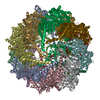 8sffC 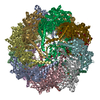 8sg8C 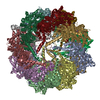 8sg9C 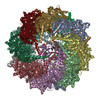 8sglC  8sgqC 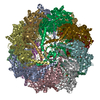 8sh9C 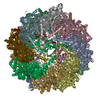 8shaC 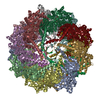 8shdC 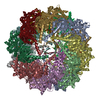 8sheC 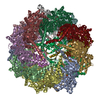 8shfC 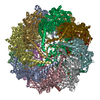 8shgC 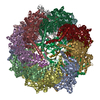 8shlC 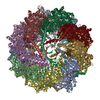 8shnC  8shoC  8shpC 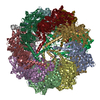 8shqC 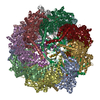 8shtC M: このデータのモデリングに利用したマップデータ C: 同じ文献を引用 ( |
|---|---|
| 類似構造データ | 類似検索 - 機能・相同性  F&H 検索 F&H 検索 |
- リンク
リンク
- 集合体
集合体
| 登録構造単位 | 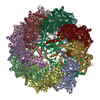
|
|---|---|
| 1 |
|
- 要素
要素
-タンパク質 , 2種, 2分子 NP
| #1: タンパク質 | 分子量: 43619.297 Da / 分子数: 1 / 由来タイプ: 天然 / 由来: (天然)  Homo sapiens (ヒト) / 細胞株: HEK293T / 組織: Kidney / 参照: UniProt: O14775 Homo sapiens (ヒト) / 細胞株: HEK293T / 組織: Kidney / 参照: UniProt: O14775 |
|---|---|
| #10: タンパク質 | 分子量: 29094.049 Da / 分子数: 1 / 由来タイプ: 天然 / 由来: (天然)  Homo sapiens (ヒト) / 細胞株: HEK293T / 参照: UniProt: Q13371 Homo sapiens (ヒト) / 細胞株: HEK293T / 参照: UniProt: Q13371 |
-T-complex protein 1 subunit ... , 8種, 16分子 AaBbDdEeGgHhQqZz
| #2: タンパク質 | 分子量: 58243.172 Da / 分子数: 2 / 由来タイプ: 天然 / 由来: (天然)  Homo sapiens (ヒト) / 細胞株: HEK293T / 組織: Kidney / 参照: UniProt: P17987 Homo sapiens (ヒト) / 細胞株: HEK293T / 組織: Kidney / 参照: UniProt: P17987#3: タンパク質 | 分子量: 56490.855 Da / 分子数: 2 / 由来タイプ: 天然 / 由来: (天然)  Homo sapiens (ヒト) / 細胞株: HEK293T / 組織: Kidney / 参照: UniProt: P78371 Homo sapiens (ヒト) / 細胞株: HEK293T / 組織: Kidney / 参照: UniProt: P78371#4: タンパク質 | 分子量: 56242.168 Da / 分子数: 2 / 由来タイプ: 天然 / 由来: (天然)  Homo sapiens (ヒト) / 細胞株: HEK293T / 組織: Kidney / 参照: UniProt: P50991 Homo sapiens (ヒト) / 細胞株: HEK293T / 組織: Kidney / 参照: UniProt: P50991#5: タンパク質 | 分子量: 59618.754 Da / 分子数: 2 / 由来タイプ: 天然 / 由来: (天然)  Homo sapiens (ヒト) / 細胞株: HEK293T / 組織: Kidney / 参照: UniProt: P48643 Homo sapiens (ヒト) / 細胞株: HEK293T / 組織: Kidney / 参照: UniProt: P48643#6: タンパク質 | 分子量: 58837.996 Da / 分子数: 2 / 由来タイプ: 天然 / 由来: (天然)  Homo sapiens (ヒト) / 細胞株: HEK293T / 組織: Kidney / 参照: UniProt: P49368 Homo sapiens (ヒト) / 細胞株: HEK293T / 組織: Kidney / 参照: UniProt: P49368#7: タンパク質 | 分子量: 57939.809 Da / 分子数: 2 / 由来タイプ: 天然 / 由来: (天然)  Homo sapiens (ヒト) / 細胞株: HEK293T / 組織: Kidney / 参照: UniProt: Q99832 Homo sapiens (ヒト) / 細胞株: HEK293T / 組織: Kidney / 参照: UniProt: Q99832#8: タンパク質 | 分子量: 58427.164 Da / 分子数: 2 / 由来タイプ: 天然 / 由来: (天然)  Homo sapiens (ヒト) / 細胞株: HEK293T / 組織: Kidney / 参照: UniProt: P50990 Homo sapiens (ヒト) / 細胞株: HEK293T / 組織: Kidney / 参照: UniProt: P50990#9: タンパク質 | 分子量: 57719.613 Da / 分子数: 2 / 由来タイプ: 天然 / 由来: (天然)  Homo sapiens (ヒト) / 細胞株: HEK293T / 組織: Kidney / 参照: UniProt: P40227 Homo sapiens (ヒト) / 細胞株: HEK293T / 組織: Kidney / 参照: UniProt: P40227 |
|---|
-非ポリマー , 4種, 67分子 

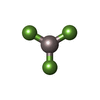




| #11: 化合物 | ChemComp-ADP / #12: 化合物 | ChemComp-MG / #13: 化合物 | ChemComp-AF3 / #14: 水 | ChemComp-HOH / | |
|---|
-詳細
| 研究の焦点であるリガンドがあるか | N |
|---|---|
| Has protein modification | N |
-実験情報
-実験
| 実験 | 手法: 電子顕微鏡法 |
|---|---|
| EM実験 | 試料の集合状態: PARTICLE / 3次元再構成法: 単粒子再構成法 |
- 試料調製
試料調製
| 構成要素 | 名称: CCT-Gb5-PhLP1 in closed state 2 / タイプ: COMPLEX / Entity ID: #1-#10 / 由来: NATURAL | |||||||||||||||||||||||||||||||||||
|---|---|---|---|---|---|---|---|---|---|---|---|---|---|---|---|---|---|---|---|---|---|---|---|---|---|---|---|---|---|---|---|---|---|---|---|---|
| 分子量 | 値: 947.77 kDa/nm / 実験値: NO | |||||||||||||||||||||||||||||||||||
| 由来(天然) | 生物種:  Homo sapiens (ヒト) / 器官: Kidney / 組織: Kidney Homo sapiens (ヒト) / 器官: Kidney / 組織: Kidney | |||||||||||||||||||||||||||||||||||
| 由来(組換発現) | 生物種:  Homo sapiens (ヒト) / 細胞: HEK 293T Homo sapiens (ヒト) / 細胞: HEK 293T | |||||||||||||||||||||||||||||||||||
| 緩衝液 | pH: 7.5 | |||||||||||||||||||||||||||||||||||
| 緩衝液成分 |
| |||||||||||||||||||||||||||||||||||
| 試料 | 濃度: 1.5 mg/ml / 包埋: NO / シャドウイング: NO / 染色: NO / 凍結: YES / 詳細: The sample was monodisperse | |||||||||||||||||||||||||||||||||||
| 急速凍結 | 装置: FEI VITROBOT MARK I / 凍結剤: ETHANE / 湿度: 100 % / 凍結前の試料温度: 277.15 K |
- 電子顕微鏡撮影
電子顕微鏡撮影
| 実験機器 |  モデル: Titan Krios / 画像提供: FEI Company |
|---|---|
| 顕微鏡 | モデル: TFS KRIOS |
| 電子銃 | 電子線源:  FIELD EMISSION GUN / 加速電圧: 300 kV / 照射モード: FLOOD BEAM FIELD EMISSION GUN / 加速電圧: 300 kV / 照射モード: FLOOD BEAM |
| 電子レンズ | モード: BRIGHT FIELD / 最大 デフォーカス(公称値): 1200 nm / 最小 デフォーカス(公称値): 800 nm / Cs: 2.7 mm |
| 撮影 | 電子線照射量: 40.42 e/Å2 / フィルム・検出器のモデル: GATAN K3 (6k x 4k) |
- 解析
解析
| ソフトウェア |
| ||||||||||||||||||||||||
|---|---|---|---|---|---|---|---|---|---|---|---|---|---|---|---|---|---|---|---|---|---|---|---|---|---|
| EMソフトウェア |
| ||||||||||||||||||||||||
| CTF補正 | タイプ: PHASE FLIPPING AND AMPLITUDE CORRECTION | ||||||||||||||||||||||||
| 3次元再構成 | 解像度: 2.9 Å / 解像度の算出法: FSC 0.143 CUT-OFF / 粒子像の数: 93128 / 対称性のタイプ: POINT | ||||||||||||||||||||||||
| 精密化 | 交差検証法: NONE 立体化学のターゲット値: GeoStd + Monomer Library + CDL v1.2 | ||||||||||||||||||||||||
| 原子変位パラメータ | Biso mean: 110.25 Å2 | ||||||||||||||||||||||||
| 拘束条件 |
|
 ムービー
ムービー コントローラー
コントローラー





















 PDBj
PDBj




























